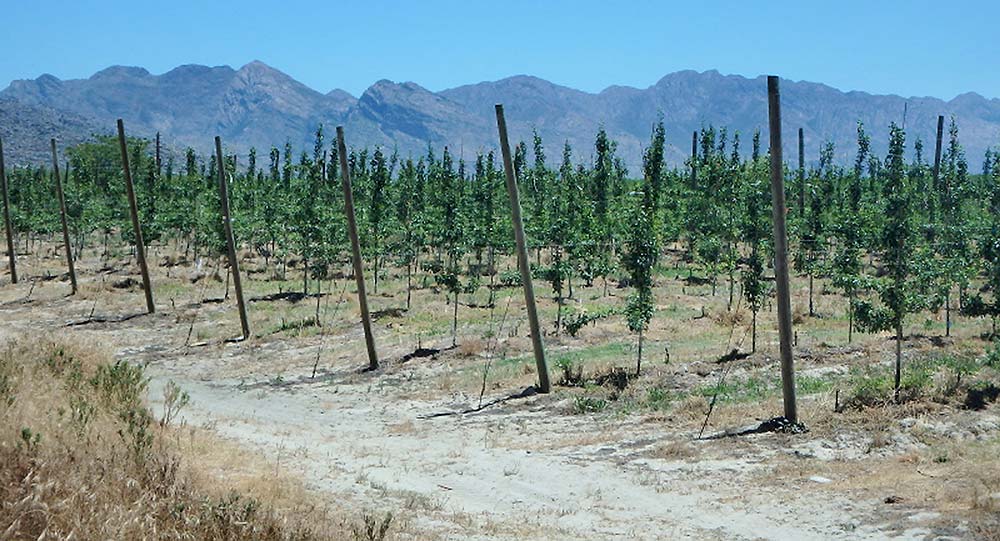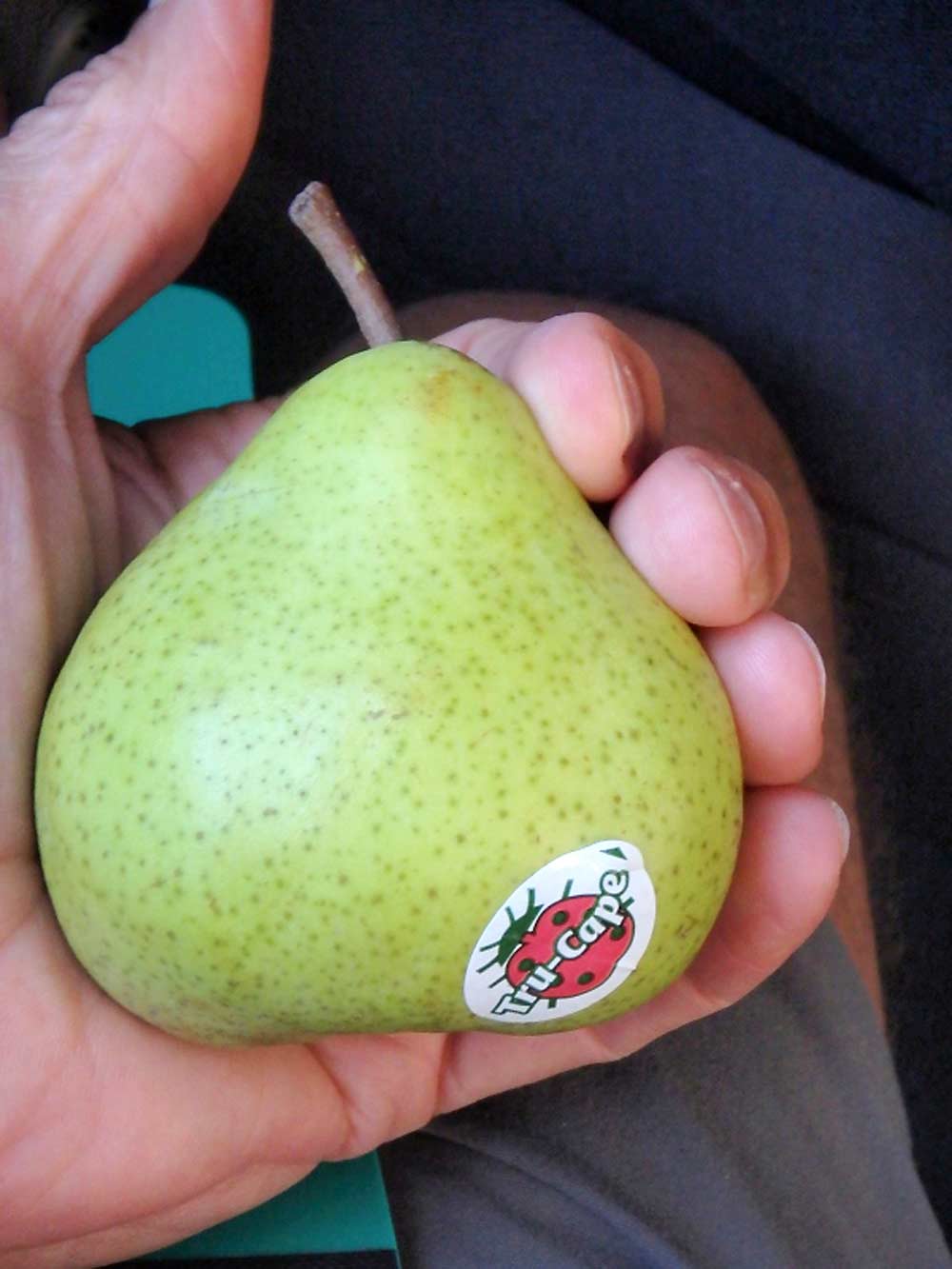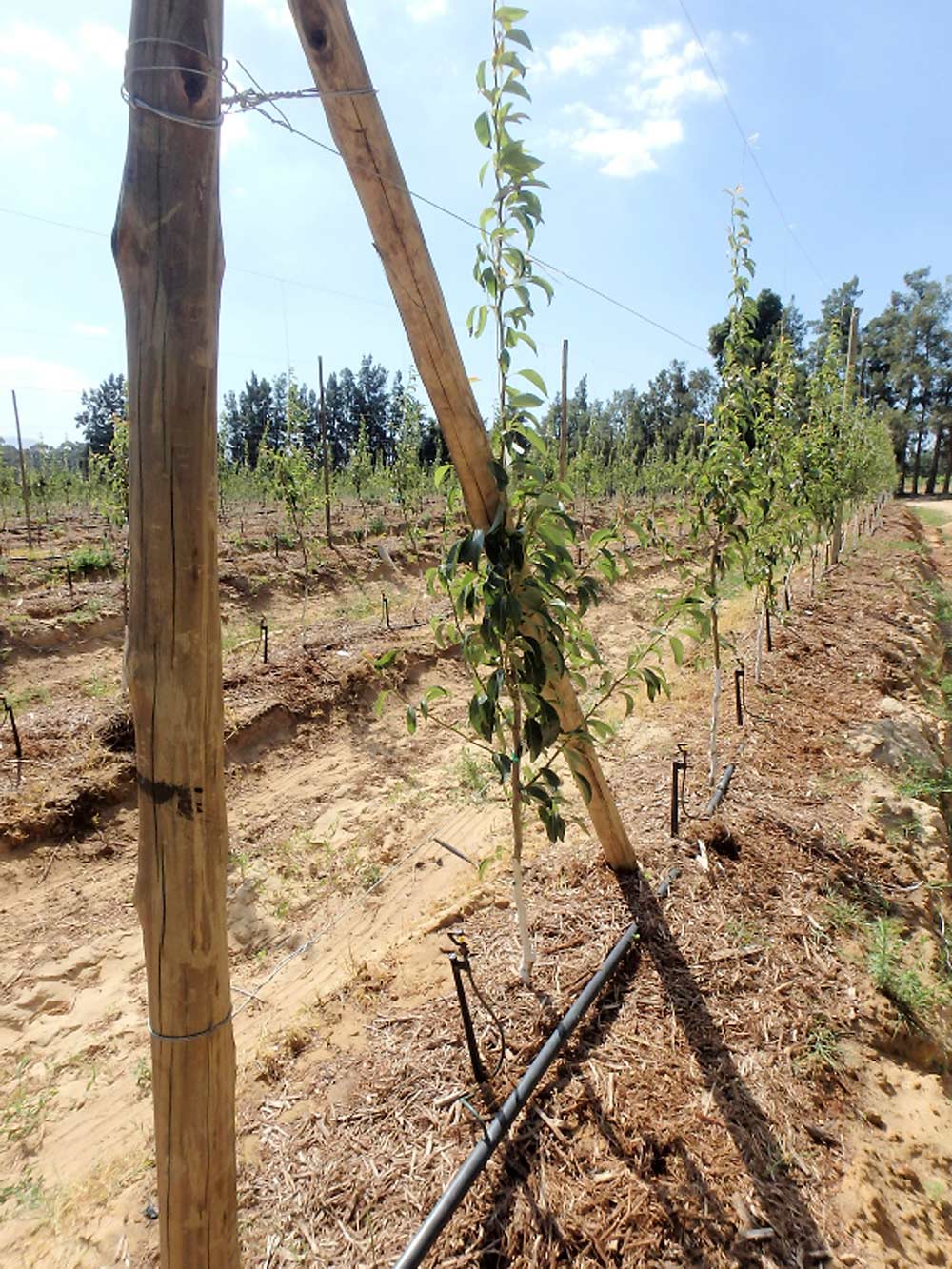
A typical pear planting in the Ceres growing area, located in the Western Cape Province of South Africa, is shown during an Interpera Congress tour in November. Trees are typically planted 5 feet apart, with 13 feet between rows, on mounded soil with vigorous rootstock. The training targets a fruit wall. (Courtesy Bob Gix)
The pear industry created the International Pear Congress, known as Interpera, to provide an opportunity for producers, marketers, handlers and researchers of pears from across the world to share research and information. Since its founding in 2009, the conference has been held annually in seven different countries: Belgium, Italy (twice), France, Spain, Argentina and Portugal, with the latest presentation in Cape Town, South Africa, in November.
I had the honor of representing Pear Bureau Northwest, the nonprofit marketing organization for Washington and Oregon pears, at the conference. (Some 95 percent of U.S. pears are grown in the Pacific Northwest.)
At the conference, Europe, New Zealand and South Africa were well represented with speakers and attendees who shared their thoughts and ideas on the state of the pear industry worldwide.
Generally, pear acreage is declining internationally outside of China, even though production per acre is increasing with newer, high-density plantings.
However, pear consumption in Europe, similar to the U.S., remains flat even as the world population is increasing.
That raises a few concerns:
Industry representatives from across the globe expressed concern about the volume of processed pears coming out of China at competitive prices, which is putting pressure on growers in several countries, including the U.S.
The risk in having a limited number of export markets is high. The Netherlands and Belgium were very dependent on exports to Russia and have struggled to recover from Russia banning those imports, a step made in retaliation for European Union-imposed sanctions on Russia for its own actions in Ukraine.
A stable economy is crucial in growers’ home countries, because it influences their ability to do business.
In addition, it’s clear that some growing areas in Europe are very competitive with each other, sometimes to their own detriment. By contrast, sales and marketing agencies in the United States are very well coordinated.
South Africa

Growers in South Africa produce high fruit volumes of Packhams Triumph, at times exceeding 70 bins an acre. The fruit size may be small at that volume, but sugars are very high and it was a good eating pear even when a bit firm. The same pear grown in the Pacific Northwest is not as smooth and has a different shape. (Courtesy Bob Gix)
In terms of pear production, South Africa produces comparable volumes to Washington, largely in three key varieties: Packhams, which are often unevenly shaped, with green-yellow skin when ripe and a soft, textured flesh; Forelles, an oblong or bell-shaped fruit with a distinctive pink blush and a sweet, juicy flavor; and Williams pears (called Bartlett in the U.S.), with yellow skin when ripe.
However, while growers in the U.S. tend to grow pears in cooler areas and apples in warmer regions, the reverse is true in South Africa. Apples there require cooler nights they find at higher elevations to color the fruit.
Growers there also don’t face the issues of fire blight and pear psylla. Their climate is closer to the central California valley with mild winters and hot summers.
South Africa also is one of the few countries in the world that has trees 10 years or younger representing roughly 20 percent of their volume. By contrast, I’d be surprised if 5 percent of the trees in the Pacific Northwest are 10 years or younger.
For that reason and others, growers in South Africa see opportunities.
Currently, almost everything South African growers produce is for export markets, much of it to Europe, but also to Russia and the Far East — markets that are mainly based on smaller to medium-sized fruit. Because the country is isolated geographically, pear growers work across commodities to support research on issues such as product cooling, food safety and sanitation and exports.
Growers in South Africa also are further ahead than most countries in terms of examining new varieties from all over the world, sometimes even before patents have been released. And they always have an eye on export markets and are exploring export opportunities in Mexico, Canada and the United States.
Overall, the trip served as a reminder that growers in the Pacific Northwest are lucky, for a number of reasons. Our climate, I believe, is more favorable than South Africa, and while their labor costs are much cheaper — growers there pay per day what growers in the U.S. might pay for a couple of hours — they also suffer from poorer soils, concerns about currency stability, and uncertainty in governance.

Trees in this newly planted orchard showed incredible performance, at 6 to 8 feet tall, with side branches. Spring-dug trees are quickly planted in hand-dug holes, with trellis and irrigation systems already in place. Growers employ frequent, yet light, irrigation and aggressive fertigation along with growth regulators to promote and maintain growth. (Courtesy Bob Gix)
U.S. growers will have their own opportunity to shine when Interpera holds its annual conference in the United States for the first time in 2017. The 10th annual Interpera Congress, which will include orchard and packing house tours and local and international speakers, will be held June 15-16 in Wenatchee, Washington.
Topics to be covered include new pear varieties available from around the world, the future of high-density plantings, an update on rootstocks, best practices for integrated pest management, orchard mechanization, best practices for the use of MCP and its effect on consumer satisfaction, and emerging and fading markets, among others.
The mission of the Interpera conference is for producers in different growing areas to share information. It’s an excellent opportunity to get a flavor of what’s happening in other places in the world of pears, and I encourage growers, packers, marketers and researchers to attend. •
– by Bob Gix is a horticulturist for Blue Star Growers in Cashmere, Washington, and is co-chair of the Fresh and Processed Pear Committees’ research subcommittee. Stay tuned to future issues of Good Fruit Grower for more on the conference or visit interpera.weebly.com.






Leave A Comment